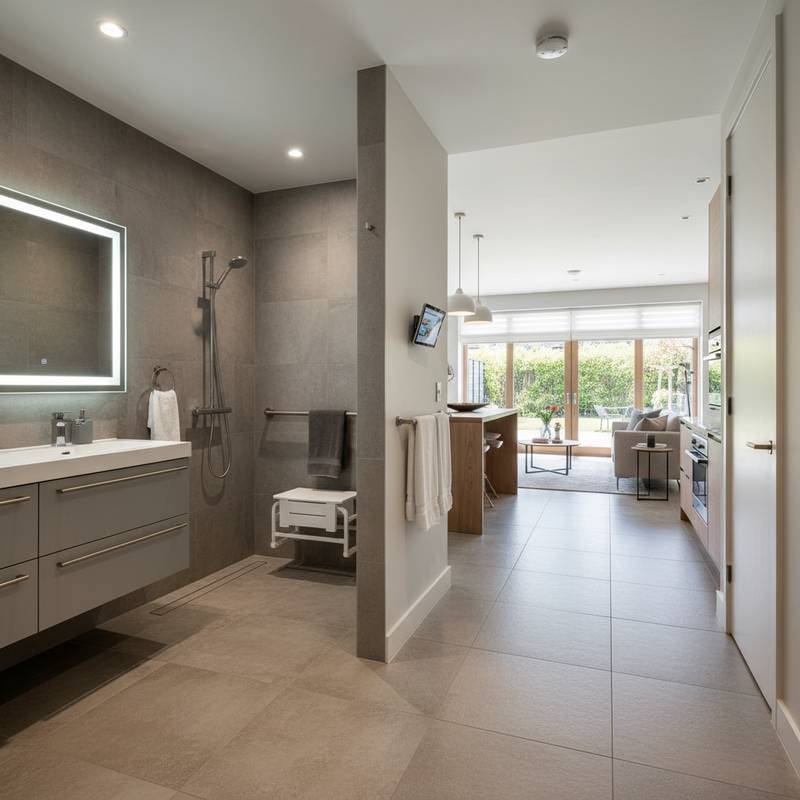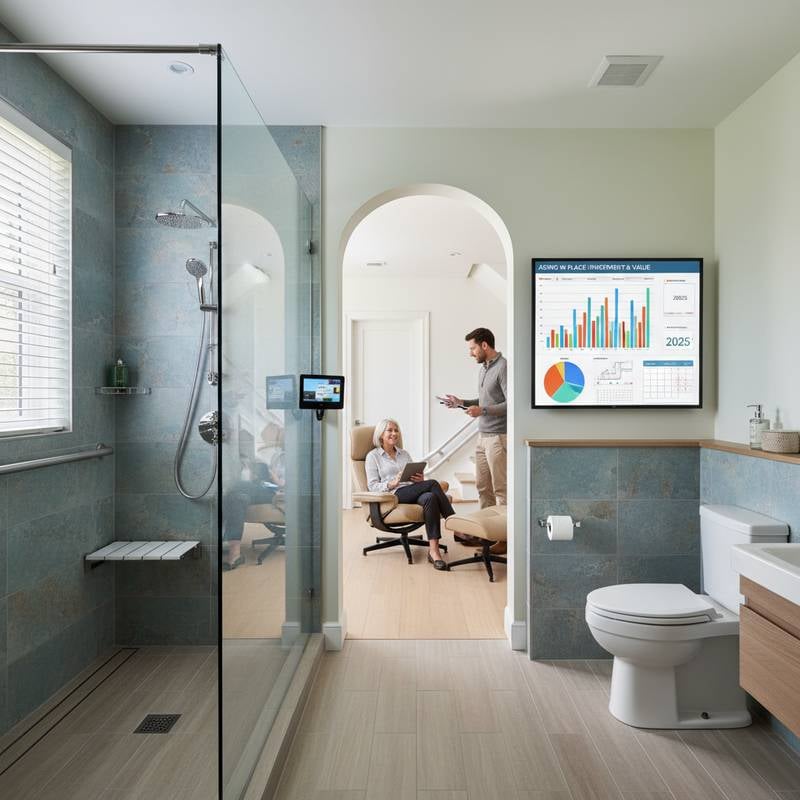2025 Aging-in-Place Remodel Costs: What to Expect
Aging-in-place remodeling enables homeowners to remain in their residences comfortably and safely as physical needs evolve. This article details the factors that influence remodel costs, outlines common updates, and provides strategies for developing a realistic budget to foster sustained independence.
Understanding the Concept of Aging-in-Place Design
Aging-in-place design prioritizes accessibility, comfort, and safety through the application of universal design principles. These principles create environments that accommodate individuals across various ages and abilities, eliminating the need for subsequent specialized modifications. The objective is to develop adaptable living spaces that address current requirements and anticipate future demands, thereby minimizing the frequency of extensive renovations.
Universal design incorporates elements such as unobstructed pathways, lever-operated door handles, barrier-free showers, and thoughtfully placed lighting fixtures. These components integrate functionality with visual appeal, ensuring the home maintains a welcoming atmosphere rather than an institutional feel. Implementing these features proactively enhances property value and lowers long-term expenses associated with repairs or alterations.
Typical Price Ranges by Project Type
Costs for aging-in-place projects fluctuate based on geographic location, contractor rates, and material selections. The following overview offers estimates for prevalent modifications, assuming average U.S. market conditions in 2025. Homeowners should obtain localized quotes for precision.
1. Bathroom Remodeling
Bathrooms represent a critical area for enhancing accessibility and preventing accidents.
- Curbless shower installation: Expect costs between $5,000 and $12,000, elevated by requirements for advanced waterproofing membranes and precise floor sloping to direct drainage.
- Grab bars and slip-resistant flooring: Budget $500 to $2,500, yielding substantial safety advantages through reinforced stainless steel bars and textured porcelain or vinyl tiles.
- Comfort-height toilets and adjustable showerheads: Allocate $300 to $1,000 for these enhancements, which facilitate easier use with elongated bowls at 17 to 19 inches high and handheld sprayers on extendable hoses.
A comprehensive bathroom overhaul incorporating universal design may total $15,000 to $30,000, particularly when repositioning plumbing fixtures or altering room configurations proves necessary.
2. Kitchen Updates
Kitchens demand designs that promote safe and efficient meal preparation.
- Lowered countertops and pull-out shelves: Plan for $2,000 to $6,000 to adjust surfaces to 28 to 34 inches in height and install glide-out cabinet organizers for reduced bending.
- Lever handles and touchless faucets: Invest $200 to $800 in these intuitive controls, which simplify operation for those with limited grip strength via single-motion levers and sensor-activated spouts.
- Accessible appliances: Select models costing $1,500 to $5,000 more than standard versions, including wall-mounted ovens at countertop level, side-by-side refrigerators with front dispensers, and under-counter microwaves.
An extensive kitchen renovation guided by universal design principles ranges from $20,000 to $50,000, influenced by selections in cabinetry, countertops, and structural adjustments.
3. Entryways and Doorways
Expanding access points facilitates seamless movement throughout the home.
- Widening door frames: Anticipate $1,000 to $4,000 per doorway, with expenses rising if load-bearing walls require reinforcement during the expansion to 36 inches.
- Ramps or zero-step entries: Allocate $3,000 to $10,000, depending on concrete or composite materials and the ramp's gradient to comply with 1:12 slope standards for wheelchair access.
- Automatic door openers: Budget $800 to $2,500, involving electrical wiring for swing-arm operators that activate via remote or proximity sensors.
These modifications not only boost daily usability but also elevate market appeal for prospective buyers seeking inclusive features.
4. Flooring and Lighting
Selecting appropriate surfaces and illumination minimizes hazards associated with navigation.
- Non-slip flooring materials: Choose options priced at $3 to $10 per square foot, such as luxury vinyl planks with rubberized underlayment or cork tiles that provide cushioning and traction.
- Under-cabinet and pathway lighting: Install LED strips for $500 to $1,500, positioning them to illuminate work areas and corridors without glare.
- Motion sensors or smart lighting systems: Expect $1,000 to $3,000 for automated setups that adjust brightness via apps or voice commands, enhancing visibility while conserving energy.
5. Whole-Home Accessibility
Multilevel residences or intricate floor plans may necessitate broader interventions.
- Stair lifts or residential elevators: Costs span $3,000 to $15,000 for curved-rail stairlifts or $30,000 to $60,000 for compact home elevators with hydraulic operation.
- Smart home integration: Invest $2,000 to $8,000 in voice-activated controls for thermostats, locks, and shades through platforms like Google Home or Alexa.
- Reconfigured hallways or doorways: Budget $5,000 to $20,000 to straighten paths and install pocket doors that slide into walls, optimizing space flow.
Such comprehensive upgrades, often totaling $50,000 to $150,000, ensure enduring adaptability across the entire property.
Practical Cost Planning Tips
Effective budgeting forms the foundation of successful aging-in-place projects. Consider these strategies to navigate the financial aspects with confidence.
-
Prioritize Safety First
Target modifications that mitigate falls and enhance navigation, such as installing grab bars in bathrooms, upgrading to non-slip floors throughout high-traffic zones, and adding motion-activated lights in hallways. These interventions provide immediate risk reduction and justify their upfront investment through prevented medical expenses. -
Plan in Phases
Divide the work into stages aligned with urgency and budget availability. Complete high-priority areas like entryways and bathrooms in the initial phase, then address kitchens and whole-home systems in subsequent years as funds permit and needs progress. -
Consult a Certified Aging-in-Place Specialist (CAPS)
Engage professionals certified by the National Association of Home Builders who specialize in seamless integration of accessibility features. Their expertise prevents inefficient designs, such as mismatched fixture heights, that could lead to rework and added costs. -
Compare Contractor Estimates
Solicit at least three itemized proposals specifying labor hours, material grades, and project milestones. Review for inclusions like permits and warranties to identify value and avert hidden fees during execution. -
Explore Financing or Tax Incentives
Investigate options including home equity loans with rates around 7 percent in 2025, or federal tax credits under the Residential Clean Energy Credit for energy-efficient upgrades. Confirm eligibility through IRS guidelines or state housing programs tailored to accessibility improvements. -
Balance Aesthetics and Function
Select durable yet stylish elements, like matte-finish hardware in brushed nickel or neutral-toned flooring that complements existing decor. This approach maintains personal expression while ensuring practical benefits endure.
Common Questions About Aging-in-Place Remodel Costs
How do I decide which updates to start with?
Assess daily routines to identify pain points, such as difficulty entering the shower or reaching kitchen cabinets. Prioritize those spaces, consulting an occupational therapist for personalized recommendations on mobility aids.
Will these upgrades increase my home’s value?
Accessibility enhancements appeal to a growing demographic, potentially boosting resale by 5 to 10 percent according to real estate analyses. Professional installations with warranties further assure buyers of quality and compliance.
Can I do any of this work myself?
Tackle straightforward tasks like mounting grab bars with wall anchors or swapping standard handles for levers, using tools available at hardware stores. Delegate complex elements involving plumbing rerouting, electrical upgrades, or load-bearing alterations to licensed experts to uphold safety codes.
How long does a remodel take?
Timeline varies by scope: minor additions like lighting may conclude in 2 to 5 days, while full bathroom or kitchen overhauls extend to 4 to 8 weeks, factoring in material lead times and subcontractor coordination.
Steps to Launch Your Remodel
Initiate the process by conducting a home audit to pinpoint mobility barriers, such as narrow doorways or dim stairwells. Collaborate with a CAPS-certified contractor to draft a customized plan that aligns budget with priorities. Through deliberate phasing and informed choices, transform your living space into a secure haven that supports independence well into the future.











